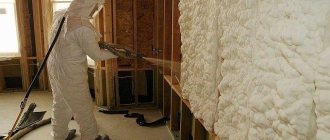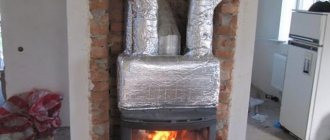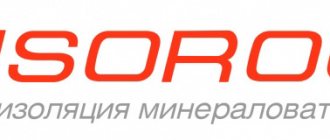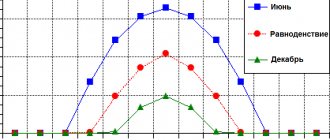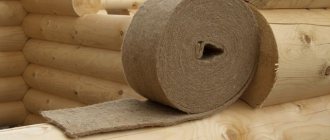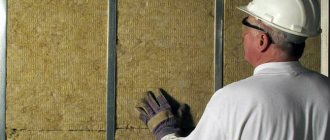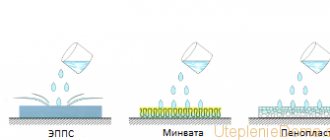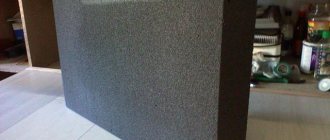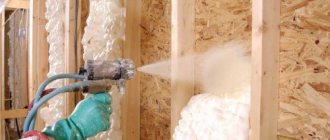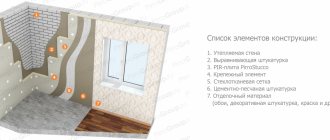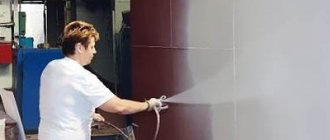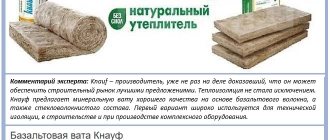| Place | Name | Characteristics in the rating |
| The best insulation for external walls |
| 1 | Polyurethane foam (PPU) Wetisol SprayFoam-50 | The most effective external insulation |
| 2 | Extruded polystyrene foam (XPS) PENOPLEX Comfort | Durable insulation with high strength |
| 3 | Ecowool SoundGuard EcoAcoustic | The most environmentally friendly insulation |
| 4 | Foam plastic PSB-S 15 | Best price |
| 5 | Thermal insulation ETIZ Steam glass Strong 180 | Thermal and noise insulation of a new generation |
| The best insulation for walls from the inside |
| 1 | Wicanders technical plug | Universal natural insulation |
| 2 | Fiberboard boards GB-600 | Innovative thermal insulator |
| 3 | Mineral wool ISOVER Optimal | Convenient installation, high popularity |
| 4 | Liquid thermal insulation Altermo Standard | The thinnest layer of thermal insulation |
| 5 | Penofol 2000 | Combined insulation |
Comparison of insulation materials for flammability
We bring to your attention a video with tests of common insulation materials for flammability.
| Flammability of basalt insulation | Flammability of extruded polystyrene foam |
| Flammability of foam plastic | Flammability of polyurethane foam |
Styrofoam
Budget material, almost 98% consisting of air. 2% comes from the main component of the raw material – polystyrene. Can be used as insulation for walls outside and inside a country house.
Technical characteristics of polystyrene foam Source probalcony.ru
Properties and advantages of polystyrene foam
Among the advantages of this material:
- Versatility and ease of installation. This material is used for insulation of any structures. It is easy to cut and installation does not take much time.
- Low price. One of the cheapest insulation materials.
- Safety. During operation, it does not generate dust or harmful fumes. You can work with it without protective equipment.
However, polystyrene foam is a flammable material; in direct contact with fire, the sheets easily catch fire and the release of harmful substances begins.
Advice! It is not advisable to insulate wooden buildings with polystyrene foam.
Does not allow steam to pass through and practically does not absorb moisture. A significant disadvantage is its attractiveness to rodents. Rats and mice easily make passages in the foam and create holes.
One of the disadvantages of polystyrene foam is flammability Source depstroi.ru
Features of wall insulation with foam plastic
Instead of guide metal profiles, you can use wooden blocks. This method is very convenient when working with foam. The thickness of the foam sheet should be equal to the thickness of the bars, which will be guides for attaching the insulation between them.
Depending on the width of the foam, the step of fixing the bars to the wall is selected. Waterproofing is fixed over the surface of the entire resulting structure. Sheets of foam plastic are tightly inserted into the resulting recesses between the beams - this avoids additional fixation. If necessary, the joints are filled with polyurethane foam.
Review of hygroscopicity of thermal insulation
High hygroscopicity is a disadvantage that needs to be eliminated.
Hygroscopicity is the ability of a material to absorb moisture, measured as a percentage of its own weight of insulation. Hygroscopicity can be called the weak side of thermal insulation and the higher this value, the more serious measures will be required to neutralize it. The fact is that water, getting into the structure of the material, reduces the effectiveness of the insulation. Comparison of hygroscopicity of the most common thermal insulation materials in civil engineering:
| Name of material | Moisture absorption,% by weight |
| Minvata | 1,5 |
| Styrofoam | 3 |
| PPU | 2 |
| Penoizol | 18 |
| Ecowool | 1 |
A comparison of the hygroscopicity of home insulation showed the high moisture absorption of foam insulation, while this thermal insulation has the ability to distribute and remove moisture. Thanks to this, even when wet by 30%, the thermal conductivity coefficient does not decrease. Despite the fact that mineral wool has a low percentage of moisture absorption, it especially needs protection. Having absorbed the water, it holds it, preventing it from leaving. At the same time, the ability to prevent heat loss is catastrophically reduced.
To prevent moisture from entering the mineral wool, vapor barrier films and diffusion membranes are used. Basically, polymers are resistant to prolonged exposure to moisture, with the exception of ordinary polystyrene foam, which quickly deteriorates. In any case, water does not benefit any thermal insulation material, so it is extremely important to exclude or minimize their contact.
It is possible to organize autonomous gas heating in an apartment only if you have all the permits (the list is quite impressive).
The payback period for alternative heating of a private house with hydrogen is about 35 years. Is it worth it or not, read here.
Top 10 best insulation for home
HeatKnauf NORD
This type of thermal insulation materials is very simple not only in the installation process, but also does not require additional care during operation. It is produced by a world-famous company that has been specializing in the manufacture of high-quality products for building construction and interior decoration for many years. Insulation is used both by professional builders who pay special attention to quality at every stage of the work performed, but also by homeowners who seek to give preference to the best materials. With the help of such insulation it is possible to reduce heating costs by about 30-40% even in the harshest winter. The material is durable, withstands temperature and other physical stress well, and is well suited for working in conditions with extremely low temperatures. It is produced using a unique technology in one layer (mono layer), which allows you to maintain the integrity of the slab even under strong impacts. The Fine Fiber method of maximally elastic fiber is also used here.
The product contains about a third more fibers compared to other insulation materials. It retains heat well despite the small thickness of the mat and is characterized by increased hardness. The product is suitable for both external and internal work - it does not emit harmful substances at all. The material has increased hardness and elasticity. It retains its beneficial qualities for 50 years and is absolutely moisture resistant. This insulation can be used to cover any base - roofing, frame walls, internal partitions, ceilings.
More: Top 10 best gas and gas-wood stoves for saunas
Advantages:
- Convenient during installation;
- Reasonable cost;
- Long service life;
- Does not irritate the skin of the hands - you can work without gloves;
- Versatile in use.
Flaws:
- It can harbor mice.
HeatKnauf NORD
Rockwool Light Butts extra
It is made on the basis of natural rock – basalt. Absolutely environmentally friendly insulation, which is a multifunctional solution for working in individual housing construction. Well suited for load-bearing and self-supporting structures, as well as for non-load-bearing partitions. In particular, it can be used to insulate three-layer walls, the finishing of which is made using small-format materials. It is allowed to insulate surfaces both outside and inside the room, floors, ceilings. The product is characterized by increased strength, resistance to temperature influences, and a high thermal insulation effect. Installation does not involve complex work on preparing the base and installing insulation, so even a novice builder can do it.
The material feels good both in vertical and horizontal positions - the maximum height of slabs installed on top of each other can reach 6 meters, and they are allowed to insulate even inclined structures, for example, roofs. It does not shrink and remains rigid throughout its entire service life. It is characterized by increased vapor permeability - excess moisture will not accumulate in the rooms. Also, the insulation does not create additional load on the walls.
Advantages:
- Does not burn;
- Differs in insignificant mass;
- During operation it is not subject to deformation;
- Long service life;
- Universal to use;
- It has high vapor permeability and improved sound insulation characteristics.
Flaws:
- It's quite expensive.
Rockwool Light Butts extra
ISOVER Warm Home Stove
This material is based on very thin fibers, which are obtained by melting mineral raw materials at a very high temperature. The product is produced in the form of slabs that can be easily cut and sawed. The insulation does not conduct heat well through itself, but water vapor escapes through it almost instantly - you don’t have to worry about the formation of mold. It can also be used as thermal insulation. This characteristic is ensured due to the special structure of the material, because the air gap located between the fibers dampens not only sound, but also vibration vibrations. The product is non-flammable, so it is absolutely safe to use, which allows it to be used for finishing frame, wooden and cobblestone houses. The weight of the slabs is insignificant, the service life is at least 50 years. During the manufacturing process, insulation materials are treated with special water-repellent agents, which ensure high water-repellent qualities.
It is not advisable to use this product for interior decoration, since it is produced with the addition of phenol-formaldehyde resins, which are used as a binder for fibers. Over time, they begin to release harmful fumes into the environment, which can harm human health.
Advantages:
- In addition to high-quality thermal insulation, it has high sound insulation and water-repellent characteristics;
- Long service life - from 50 years or more;
- Low price;
- Insignificant mass of material.
Flaws:
- Not recommended for residential use.
ISOVER Warm Home Stove
PENOPLEX Comfort
It is used quite often in professional and individual construction. Has excellent technical parameters. Essentially, the material is extruded polystyrene foam. High quality is ensured largely due to the cellular structure of the product. The size of the cells ranges from 0.1 to 0.2 mm. They are located as evenly as possible in the structure, which has a positive effect on the strength of the material itself and allows it to provide not only thermal insulation, but also sound insulation characteristics. It is worth noting that the cells are not isolated, but connected to each other. Water vapor escapes through such passages without lingering in the room. The sheets have edges made in the shape of the letter “L”, which not only greatly facilitates the installation process, but also reduces heat loss. As a rule, islands of cold appear at the joints of slabs; this does not happen when working with such material.
This is one of the lightest materials in our review - its density is a maximum of 35 kg/cub.m. The insulation does not absorb moisture and retains its original shape even under significant physical stress - its compressive strength is 0.2 MPa. The thickness of the slabs ranges from 2 to 12 cm. They are allowed to be used for interior decoration, since they do not emit toxic substances. The slabs have performed well in roof insulation, and they also have an extended temperature range from -50 to +75 degrees. There is no fungus or mold in their structure. The strength of the insulation is much higher compared to foam plastic, and it does not crumble. Due to the grooves, endurance in relation to physical influences increases.
More: Top 10 best jackhammers, which jackhammer to choose?
Advantages:
- Inexpensive material;
- Has expanded functionality;
- Absolutely harmless to humans;
- Easily withstands any physical activity;
- Easy to install;
- You can work without using protective equipment.
Flaws:
- Some users say that it quickly infests ants.
PENOPLEX Comfort
TechnoNIKOL Rocklight
This type of insulation is a non-combustible slab made from thin threads of rocks; the thickness of the material can be 50 or 100 mm. It can be used for additional sound insulation of residential, industrial and office premises, that is, places where people spend quite a lot of time. The insulation is very easy to install, so it is often used not only on large construction projects, but also in the construction of residential buildings. The mineral wool board is made from rocks and has extremely low thermal conductivity - according to this indicator, it is almost on par with the most expensive materials available on the market today. This product does not allow combustion processes to spread; it can withstand temperatures up to 450 degrees. The insulation retains its shape and size throughout its entire service life.
With its help, up to 97% of sound waves are absorbed, while it does not absorb moisture, however, a special vapor barrier will need to be laid on top of the material. The product does not rot or decompose during use; neither insects nor rodents live in it. Mold and mildew will also not develop in these products.
Advantages:
- The service life of the insulation is about 50-60 years;
- Pathogenic microorganisms do not grow in it, insects and rodents do not live;
- A high level of vapor barrier can provide excellent ventilation for the wooden walls of a house.
Flaws:
- You must wear protective gloves when working, and wear a respirator when cutting.
TechnoNIKOL Rocklight
Ecoplanet Linen Insulation
It is made exclusively on the basis of natural materials, which give this product unique performance qualities. The products are produced in the form of flexible slabs, intended primarily for internal thermal insulation of roofs, attics, walls, floors, ceilings, attic floors, partitions, and so on. Thermal insulation material is excellent for private construction, but it is often used for civil and industrial buildings. Linen products allow you to create the most comfortable microclimate in a room, which is very important in frame buildings, where insulation is the main building material. The product is absolutely environmentally friendly, there are no foreign odors in the room, and no harmful substances are released. The wooden structure receives high-quality protection against fungus and mold.
Excellent thermal insulation performance is achieved largely due to the low thermal conductivity coefficient and increased heat capacity of the material. It is worth noting that the product also has bactericidal characteristics, so it additionally purifies the air in the room. Despite the fact that the insulation is made exclusively from natural materials, it is not at all susceptible to rotting and allows moisture to pass through it well, without absorbing it. The service life is very long - about 70 years, the final load on the supporting structures is small. Installation is simple, does not require special skills and takes minimal time.
Advantages:
- Well suited for interior decoration;
- Does not absorb moisture;
- Features a long service life;
- Has high sound insulation characteristics.
Flaws:
- Relatively expensive;
- Not found in every hardware store.
Ecoplanet Linen Insulation
Steico Flex
Also called Woodflex, it is an environmentally friendly insulating material made from natural wood fibers. It can be used to fill elements of roofs, floors and walls during frame construction, and is suitable for thermal insulation of technical rooms and utilities. The product is quite elastic, so it is comfortable to finish even quite complex shapes. The insulation is absolutely safe to use; there is no need to worry about the release of chemical compounds into the air in the room; it is also not capable of causing an allergic reaction. Such slabs are easy to install, since no large amount of debris is generated during operation. Thermal insulation characteristics are very high due to the fact that during the manufacture of slabs, wood retains all its basic natural qualities. Each fiber of the material has the ability to absorb and accumulate heat. Using this feature, a comfortable atmosphere will be created in the house, and daytime temperature fluctuations will be minimized, which is most important on hot summer days.
Moisture can accumulate in the material, but its beneficial qualities will remain at the same level. Even if one cubic meter of insulation contains about 10 liters of water, it will still be able to maintain its original shape without a hint of deformation. The unique structure also provides fairly high sound insulation characteristics.
Advantages:
- Easy to install on any surface;
- Can be used as a filler in frame construction;
- Long service life;
- Excellent sound insulation performance.
Flaws:
- Ability to absorb moisture.
Steico Flex
Isobox plate
This insulation was released onto the market back in 2007 - it is manufactured by a fairly well-known domestic company, founded in 1992 and specializing in the production of finishing and building materials. The latest scientific developments, as well as the most modern technologies, were used to create products. Largely due to this, the insulation fully complies not only with Russian, but also with international standards. The basis here is mineral wool, which is an absolutely environmentally friendly material. With its help, you can significantly reduce heat loss, retaining heat inside the room. This product easily interacts with various chemicals contained in masonry materials. It does not react with plaster and other solutions, gypsum, or dry mixes.
More: TOP 10 best fans for bathrooms and toilets
Thermal conductivity is practically zero, but it is necessary to lay the insulation in such a way that it does not come into contact with water. Otherwise, it begins to lose its useful characteristics. However, mineral wool easily withstands mechanical and physical stress and can be installed even in rooms with an aggressive environment. Despite the fact that the material is afraid of water, it easily passes water vapor through itself.
Advantages:
- Environmentally friendly composition;
- Convenient to use;
- Minimum level of thermal conductivity;
- Low cost.
Flaws:
- When working with such insulation, it is necessary to wear protective gloves, otherwise skin irritation is guaranteed;
- Afraid of exposure to moisture.
Isobox plate
Shelter EcoStroy Premium
Heat and sound insulating material made on the basis of polyester fibers. No harmful elements or adhesives are added during the manufacturing process. The technology used is thermal bonding of fibers, that is, they are connected to each other under the influence of only high temperature. Insulation can be used not only for walls, but also for other purposes - for example, for working with communications and utility networks. Designed for professional and household use. During installation it does not emit dust and does not irritate the skin and mucous membranes - it is allowed not to use personal protective equipment. During the work, there are no scraps left that could not be used in the future, which allows you to seriously save on working with such material. The insulation itself has no odor at all and does not cause allergic reactions.
The main difference from other materials is their unlimited service life. It can be dismantled from one place and installed somewhere else. Practically does not absorb water and always remains dry. Helps extend the life of wood, since moisture will not affect it. Thanks to the original technology, thermal insulation is unsuitable for the growth of fungal microorganisms, mold and other bacteria, although it consists entirely of organic fibers. According to users, it is an excellent barrier that prevents rodents from entering the house.
Advantages:
- High-quality material that can be used for various purposes;
- Made on a natural basis, does not cause allergies;
- Insensitive to water, fungi, mold.
Flaws:
- Quite expensive;
- Does not withstand high temperatures.
Shelter EcoStroy Premium
Isomin
The main raw material for this product is basalt rock, which is first crushed and then melted into fibers. They are held together with a binder based on synthetic materials, then the insulation is formed into slabs or rolls. The organic content here is low - about 4-5%. As a result, a fibrous structure is formed, where the main part is air. It is with its help that it is possible to minimize heat loss and create an obstacle to the passage of sound waves. The material is resistant to acids, alkalis, and other active chemical compounds, and has excellent thermal resistance. The products are absolutely environmentally friendly, as evidenced by the relevant certificates; they are also distinguished by their hypoallergenic properties.
The insulation is able to withstand temperatures up to 1000 degrees, while maintaining its structure and performance characteristics, so it is often used to treat the passages of exhaust pipes through wooden floors and roofs. It is allowed to be used for thermal insulation of hot water pipelines and boiler rooms. A high degree of vapor permeability prevents condensation and wetting of the insulated base. The product has excellent resistance to mechanical stress. The average service life is about 50 years.
Advantages:
- Acceptable cost of material;
- Sufficiently high density and strength, despite the low weight;
- Excellent quality;
- Retains heat and sound waves well;
- Does not allow condensation to form;
- There is no smell;
- Made from environmentally friendly materials.
Flaws:
- Not very convenient packaging.
Isomin
Foamed foil polyethylene
Soft and lightweight material belonging to the group of reflective thermal insulation in accordance with GOST R 56734-2015. However, the reflective properties are much lower than those of PIR boards; this is directly related to the quality of the laminating cladding. If Logicpir slabs are lined on both sides with high-quality aluminum foil 50 microns thick, then the insulation based on foamed polyethylene is covered on only one side with lavsan film with a metallized coating - an analogue of foil.
Foamed foil polyethylene
The available range of insulation thicknesses is from 2 to 20 mm. This is not enough to fully insulate the walls of a house or roof, but the material is used quite often as a substrate for floor coverings, including when installing heated floors.
Foamed foil polyethylene is best used in combination with other insulation materials to increase the service life of the entire insulation pie, protect structures from moisture and improve sound insulation properties.
Foamed foil polyethylene, despite a number of significant disadvantages, also has positive qualities, such as:
- versatility;
- safety;
- light weight;
- easy installation.
The material is easily cut with a sharp construction knife, and the joints are taped with aluminum tape.
Sealing joints of foam polyethylene sheets
Laying can be done even at sub-zero temperatures, the main thing is that during operation the material does not heat above +100°C.
Organically types of insulation
Cellulose insulation
It is made from wood waste and recycled paper. It has very low thermal conductivity, good vapor permeability, and sound insulation. Environmentally friendly.
It is applied to surfaces by dry or wet spraying or by simply pouring material into ceilings or between walls.
To eliminate the high flammability of the material, antipyrines are added to it during production, and antiseptics are added for bioprotection.
Jute
Jute tape or rope, designed to replace traditional tow, is used mainly as inter-crown insulation in the construction of wooden log houses from round timber or construction timber.
At the same time, they speed up the construction process and eliminate the need to re-fill cracks with insulation after shrinkage of the log house after several years. They eliminate heat loss in inter-crown cracks very well.
Tow
A traditional, centuries-tested, cushioning and caulking material in wooden architecture, which is also used for inter-crown insulation in construction from logs and timber.
Cork insulation
One of the best insulation for walls from inside the house. It is made in the form of mats or rolled material from cork oak bark.
It is used for internal wall insulation, as a basis for wallpapering, and also as an independent finishing material due to its high decorative qualities.
It is also used for floor insulation as a base for laminate and other finishing coatings. The main disadvantage is the high price of the material.
Arbolite insulation
Arbolite, or wood chip concrete, has been known since the 60s of the 20th century. It is produced in the form of panels or blocks, which can be used both as an independent building material and as an additional heat insulator. They are especially often used in the construction of frame-panel houses and other buildings.
